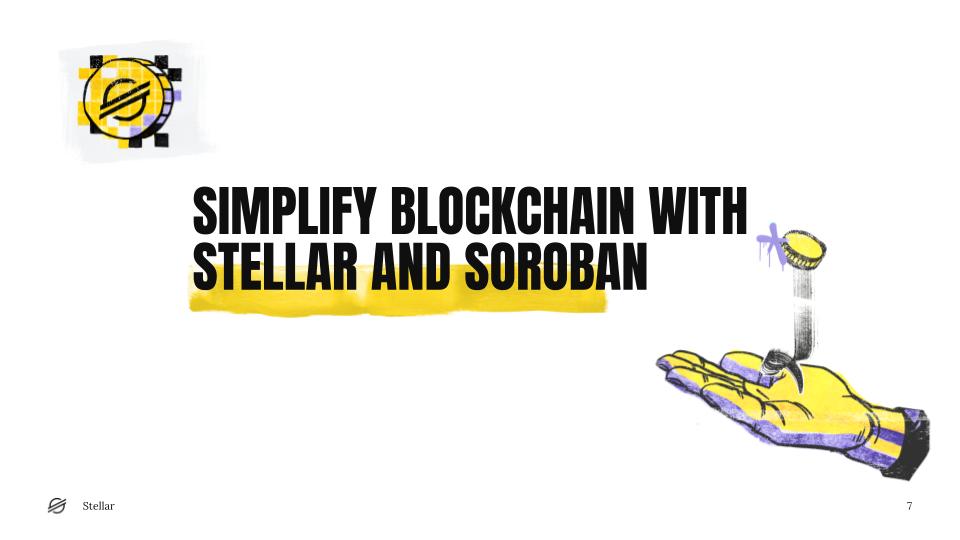Simplify Blockchain with Stellar and Soroban
 LABORE KODJO AGBETSIASSI
LABORE KODJO AGBETSIASSI
Blockchain technology can feel complex, but its goal is simple: to make transactions faster, cheaper, and more accessible worldwide. Stellar, a decentralized open financial network, and Soroban, its smart contract platform, are making waves in the blockchain space. Let's break down how they work and why they matter, in an easy-to-understand way.
What is Stellar?
Stellar is an open financial network designed to connect banks, payment systems, and people. Imagine it as a global web where anyone, anywhere, can send money across borders as easily as sending an email. No need for middlemen or expensive transaction fees – Stellar brings everyone into the same digital economy.
One of the standout features of Stellar is its ability to issue digital assets. Just as how countries issue their currencies, businesses and individuals can issue their own digital versions of traditional currencies or even new tokens. For example, a company in Togo could issue a digital version of the CFA franc, making cross-border payments seamless for businesses and individuals across Africa.
How Does Stellar Work?
Stellar operates on a network of connected nodes, known as the Stellar ledger, which tracks all accounts, balances, and transactions. Transactions are quick and cost-effective because they don’t rely on the traditional banking infrastructure. Instead, they use blockchain technology to maintain a public ledger of every transaction.
For example, if Alice in Ghana wants to send money to Bob in France, she can do this via Stellar. She transfers her digital CFA to Bob, who receives it as euros. No need to go through currency exchanges, banks, or remittance services. This type of payment, called a "path payment," is one of Stellar's unique innovations.
Introducing Soroban: Stellar’s Smart Contract Platform
Soroban takes Stellar a step further by introducing smart contracts. If Stellar is the highway that connects financial systems, Soroban is the engine that powers complex, programmable agreements. Smart contracts are like digital contracts that automatically enforce the terms when conditions are met.
Imagine you run an online marketplace. You can set up a smart contract to automatically release funds to a seller once the buyer confirms receipt of their goods. No need for an intermediary to manage the payment – the contract does it for you. Soroban allows developers to build these kinds of solutions on Stellar, unlocking endless possibilities for decentralized apps (dApps).
Real-Life Examples
Cross-Border Remittances: Maria, who lives in Mexico, works in the US and needs to send money to her family back home. Using traditional methods like Western Union or a bank transfer can be slow and expensive. With Stellar, Maria can send funds instantly and at a fraction of the cost. Her family receives the funds in their local currency, converted automatically by Stellar’s network.
Tokenized Assets: A Togolese company issues a tokenized version of its shares using Stellar. Investors worldwide can buy, sell, and trade these tokens easily. This brings liquidity and access to markets that were once hard to reach for small businesses in developing economies.
How Stellar and Soroban Compare to Everyday Things
Think of Stellar as the roads in a city and Soroban as the traffic lights. Stellar moves the cars (money and assets) from point A to point B. Soroban, the traffic lights, ensures the cars stop and go at the right times, preventing accidents (or errors). They work together to ensure a smooth, functional system.
Another way to think about it: Stellar is like your email inbox, handling messages (transactions) between people. Soroban, on the other hand, is like a filter that only lets through emails that meet certain criteria (smart contract rules).
Why This Matters
Blockchain can seem like just a fancy buzzword, but technologies like Stellar and Soroban are changing how we think about money, contracts, and the digital economy. For regions like Africa, where traditional banking systems can be limited, Stellar provides an accessible alternative that anyone with a smartphone can use. This opens up opportunities for financial inclusion and empowers individuals to participate in the global economy.
Frequently Asked Questions
1. What is Stellar? Stellar is a decentralized network that connects banks, payment systems, and people, allowing them to send and receive money across borders quickly and cheaply.
2. How are Stellar transactions different from bank transfers? Stellar transactions are faster and cheaper because they don’t rely on traditional banks. Instead, they use blockchain to record and verify transactions.
3. What is Soroban? Soroban is Stellar’s smart contract platform that allows developers to create programmable agreements (smart contracts) on the Stellar network.
4. How does Stellar help businesses in developing countries? Businesses can issue digital assets on Stellar, like tokenized shares or digital currencies, allowing them to access global markets easily.
5. Can I use Stellar to send money internationally? Yes! Stellar allows for fast and low-cost international money transfers.
Conclusion
Stellar and Soroban are more than just blockchain buzzwords. They’re tools for creating a fairer, more connected world where people can transact freely and securely. By providing the infrastructure for developers and businesses, Stellar is building bridges to financial systems that were once out of reach. If you're curious about blockchain but unsure where to start, Stellar is a great entry point to understanding how this technology can benefit everyone.
Want to learn more? Check out Stellar's official site or explore the Soroban platform to get started!
To support me, here are my crypto wallets:
EVM : 0xf249F24182CdE7bAd264B60Ed38727Fd3674FE6A
SOL : Fq9sgX7UHqEEwpVMu7UKjpstQGcf1JD3kPnUTYRbEdcZ
For more information and to see other articles, projects, you can follow me on:
LinkedIn : AGBETISIASSI KODJO LABORE
GitHub : Github Profile
Twitter : Twitter Profile
Subscribe to my newsletter
Read articles from LABORE KODJO AGBETSIASSI directly inside your inbox. Subscribe to the newsletter, and don't miss out.
Written by

LABORE KODJO AGBETSIASSI
LABORE KODJO AGBETSIASSI
My name is Laboré. I am an application developer, I do back-end and front-end programming, and server configuration and management.